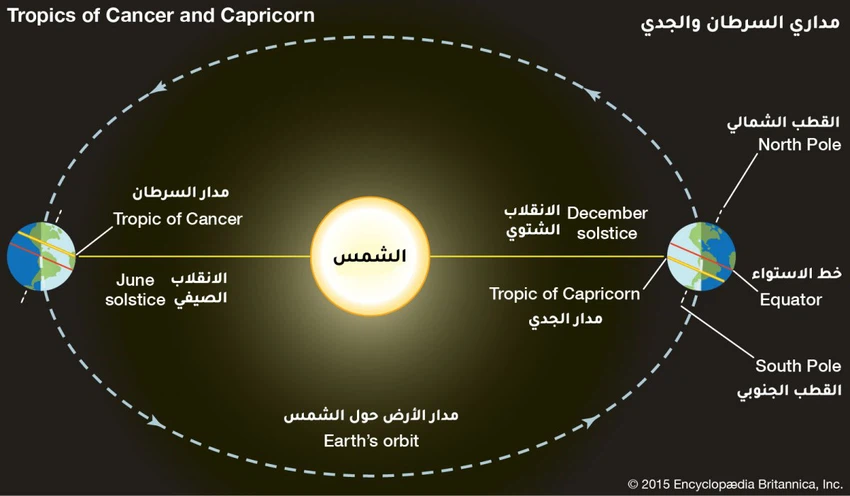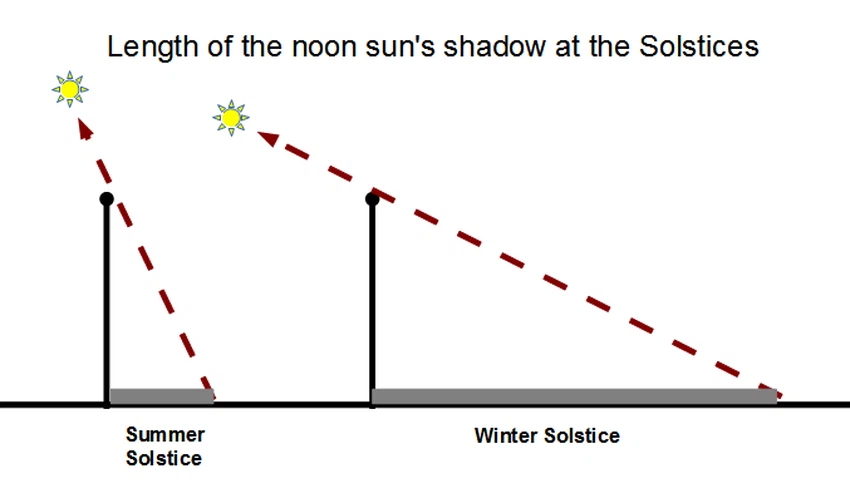Summer Solstice.. what is it? Why is it the longest day of the year?
Weather of Arabia - The summer solstice is known as the day on which the summer begins astronomically, and the day of the summer solstice is characterized by the longest day among the days of the year, and the shortest hours of the night.
The summer solstice comes every year on June 20 or 21 in the northern hemisphere, and on December 21 or 22 in the southern hemisphere, but what happens astronomically on the day of the summer solstice? Why is it the longest day of the year?
What is the summer solstice?
Because of the tilt of the Earth’s axis as it rotates around the sun, the angle of the sun’s rays falling on the Earth changes during the year, and thus the apparent sunrise and sunset point in the sky changes between north and south, meaning that the sun’s path in the sky becomes higher or lower throughout the year, and on the summer solstice the sun reaches to its northernmost point in the sky.
Then, after the day of the summer solstice (solar solstice) , the sun appears to reverse its course and start heading south, meaning that the apparent path of the sun in the sky reverses and starts heading south until it reaches the southernmost point on the winter solstice in December.
This astronomical event is accompanied by many phenomena that we witness on Earth, the most important of which are: the official beginning of summer, sunrise from the far north-east and sunset in the far north-west, the longest day and shortest night, the shortest shadow, the absence of noon shadow in the regions located on the Tropic of Cancer.
For more: Regions of Arab countries witness the phenomenon of lack of noon on June 21
What is the difference between summer solstice and winter solstice?
On the day of the summer solstice in the northern hemisphere (in the month of June), the North Pole of the Earth is at its greatest inclination towards the Sun, and the South Pole is at its farthest from the Sun, so the Sun is perpendicular to the Tropic of Cancer at 23.44°N latitude .
On the day of the winter solstice in the northern hemisphere (in the month of December), the North Pole of the Earth is at its maximum inclination away from the Sun, and the South Pole is at its maximum inclination towards the Sun, so the Sun is perpendicular to the Tropic of Capricorn at a latitude 23.44 degrees south.

You may also be interested in: Historical Landmarks Associated with the Winter Solstice
Why is the summer solstice the longest day of the year?
The summer solstice is the day on which the northern hemisphere receives the longest period of sunlight, so the day is the longest of the year. The sun's rays hit the Earth at a more direct angle, causing the effective warming we call summer, so summer officially begins on the day of the summer solstice.
Does this mean that the summer solstice is the hottest day of the year?
No, although on the summer solstice the Earth receives sunlight for the longest time of the year, the temperature usually does not reach its annual peak until after a month or two. This is because water, which makes up most of the Earth's surface, has a high specific heat, which means that it takes some time to heat up and cool down. Because of this, it takes about six weeks for Earth's temperature to reach summer levels.
The afternoon shade is the shortest of the year
Since the sun is at its highest point in the sky on this day, you will notice that your shadow at noon is the shortest of the year.

You May Also Like: 10 Fun Facts About Summer Solstice
Does the summer solstice always happen on the same day?
The timing of the summer solstice in the northern hemisphere each year depends on when the sun reached its northernmost point of the equator. So the date of the summer solstice in the northern hemisphere ranges from June 20 to 22. This change occurs due to several effects, namely:
- The gravitational influence of the moon and other planets.
- A slight fluctuation in the Earth's rotation.
- The difference between the Gregorian calendar system (which usually has 365 days) and the solar year (the time taken by the Earth to complete one revolution around the sun), which is about 365.242199 days long. To make up for the portion of missing days, the Gregorian calendar adds a leap day approximately every 4 years.
Arabia Weather App
Download the app to receive weather notifications and more..



